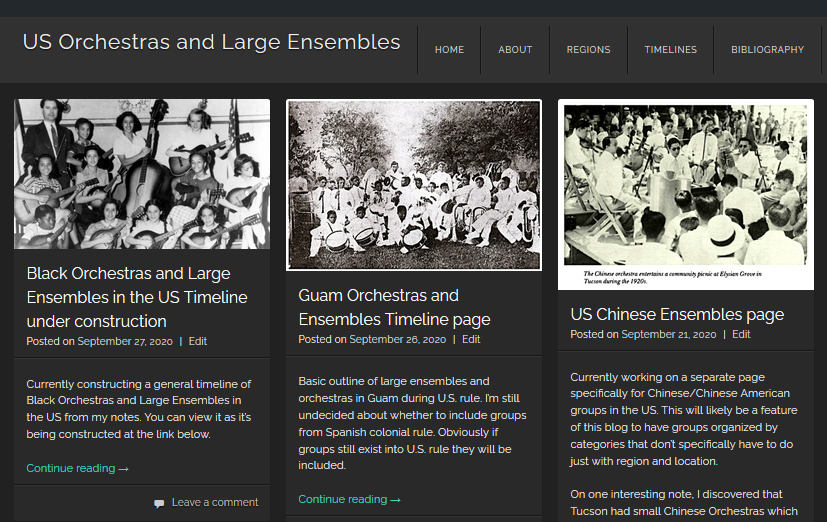
An 1870 photo of the Slave Band of Antônio Luís de Almeida.
Figure 10, pg. 66 in Luiz Cleber Moreira Freire's 2007 dissertation, "NEM TANTO AO MAR NEM TANTO À TERRA:
Agropecuária, escravidão e riqueza em
Feira de Santana - 1850-1888"
repositorio.ufba.br/ri/handle/ri/1…
1/
Figure 10, pg. 66 in Luiz Cleber Moreira Freire's 2007 dissertation, "NEM TANTO AO MAR NEM TANTO À TERRA:
Agropecuária, escravidão e riqueza em
Feira de Santana - 1850-1888"
repositorio.ufba.br/ri/handle/ri/1…
1/

Antônio Luís de Almeida was a Brazilian Coffee Baron in Bananal, São Paulo. The white guy at the top-center of the photo is German conductor, Wiltem Sholtz. Most slave orchestras and ensembles were directed by European conductors.
2/
2/
In Brazil, slavery didn't end till 1888, so finding actual photographs of slave ensembles in existence shouldn't be surprising.
This group was often called "Banda do Tio Antoniquinho" and as many slave ensembles, would have to perform diverse functions.
3/
This group was often called "Banda do Tio Antoniquinho" and as many slave ensembles, would have to perform diverse functions.
3/
For example, in Luciano Figueiredo's "Historia Do Brasil Para Ocupado" there's a description of 5 members of the Banda do Tio Antoniquinho playing a party in honor of the viscount in 1877. They played European music while receiving the guests.
archive.org/details/Histor…
4/
archive.org/details/Histor…
4/
In Claudia Felipe da Silva's masters thesis, "Bandas de musica, imigração italiana e educação musical" - the groups were rented to make income for their masters; usually at below market value which caused employment losses for professional musicians.
repositorio.unicamp.br/handle/REPOSIP…
5/
repositorio.unicamp.br/handle/REPOSIP…
5/
So the existence of slave orchestras/ensembles also disrupted the local music ecosystems, not to mention issues of cultural imperialism. The Cultural Imperialism hypothesis much discussed in the 1980s made similar points ab the Anglo-Euro Pop Music Industry doing the same.
6/
6/
Here's a photo of another slave band from Clarissa Maria Rosa Gagliardi's dissertation, "AS CIDADES DO MEU TEMPO: a experiência do turismo em Bananal-SP."
This is the slave band of the Vista Alegre Plantation in Valença. Yes, there are kids in it.
tede2.pucsp.br/handle/handle/…
7/
This is the slave band of the Vista Alegre Plantation in Valença. Yes, there are kids in it.
tede2.pucsp.br/handle/handle/…
7/

And since slavery in Brazil lasted until nearly the 20th century, some of these ensembles continued on and we have some photos of them as mixed-race ensembles w/ former slaves as members.
Banda de Música do Ginásio Musical e Recreativo 24 (1912)
joaocorrea.com.br/banda-de-music…
8/
Banda de Música do Ginásio Musical e Recreativo 24 (1912)
joaocorrea.com.br/banda-de-music…
8/

As I mentioned in another thread, Slave Orchestras and Ensembles have been recorded in Brazil since as early as 1610. Which means for Brazil, that's a nearly 300 year period (1610-1888) of legacy of the institution.
9/
https://twitter.com/Silpayamanant/status/1284682235875078144
9/
And as I've emphasized A LOT in my threads about Slave Orchestras, #Decolonialism, and DEI initiatives, as long as we (especially USians) continue to ignore the rest of the world we will continue to view all the problems/solutions through a monocultural lens.
10/end
10/end
NOTE 1: My thread charting Slave Orchestras.
https://twitter.com/Silpayamanant/status/1284326698503331843
NOTE 2: My piece summarizing the Slave Orchestra thread in NOTE 1 above.
silpayamanant.wordpress.com/2020/07/30/cla…
silpayamanant.wordpress.com/2020/07/30/cla…
P.S. Let's not forget the Brazilian slave choirs.
https://twitter.com/Silpayamanant/status/1290780510801862659
P.P.S. Also, there were Schools of Music for slave musicians in Brazil.
https://twitter.com/Silpayamanant/status/1289265696480931846
Well, looks like they’re showing up depending on how you click the tweets? *sighs*
https://twitter.com/silpayamanant/status/1316901312714461184
• • •
Missing some Tweet in this thread? You can try to
force a refresh









